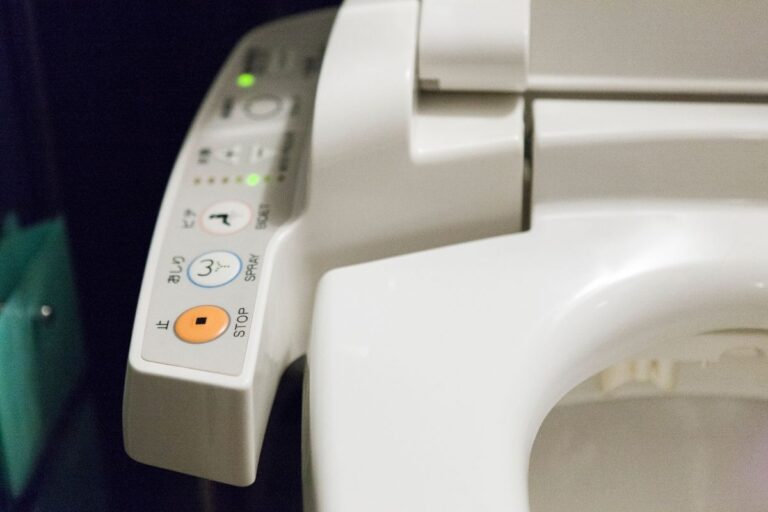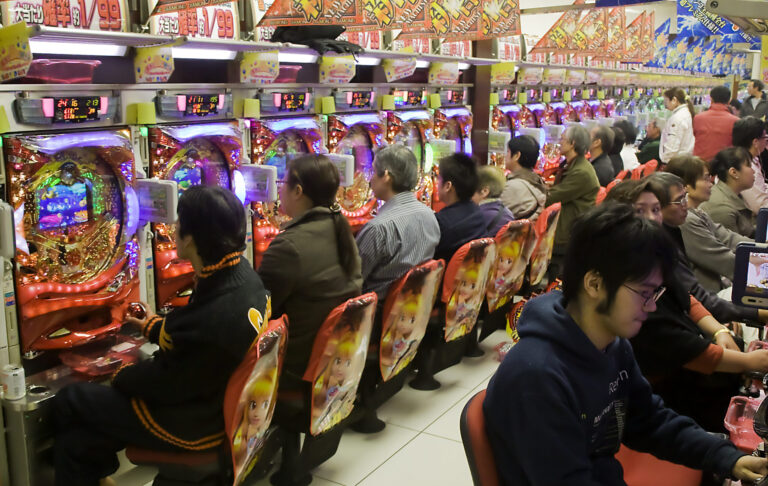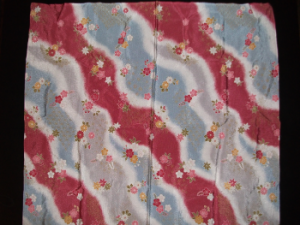 A few weeks ago, we discussed the bento lunch in Japan and briefly mentioned the wrappings via which a bento box is usually carried: the furoshiki. This very large handkerchief-like cloth is reusable and thus makes an environmentally-friendly way to transport food. (The bento box itself traditionally has no handles and is not simple to carry.) It can also double as a food mat to spread out on your desk, lap or even on the grass once you unwrap your bento box, catching spills and making clean up much easier.
A few weeks ago, we discussed the bento lunch in Japan and briefly mentioned the wrappings via which a bento box is usually carried: the furoshiki. This very large handkerchief-like cloth is reusable and thus makes an environmentally-friendly way to transport food. (The bento box itself traditionally has no handles and is not simple to carry.) It can also double as a food mat to spread out on your desk, lap or even on the grass once you unwrap your bento box, catching spills and making clean up much easier.
The furoshiki dates back to the 8th century CE, when it was originally called the hirazutsumi (“flat, folded bundle”). It became colloquially known as the furoshiki (“bath spread”) during the Edo Period (17th to 19th century CE) when it became a common practice to use the cloth to bring clothes to and from the public baths.
The furoshiki is actually used for far more than just wrapping lunch to-go. The original intent of the furoshiki was something like a modern grocery bag or tote bag, allowing the user to transport food, shopping goods, and other items. It could also be used to protect boxes and items from dust during storage. The furoshiki was even used like wrapping paper for gifts. (Traditionally, the giver receives the wrappings back.) These uses are still prevalent today, particularly for those who wish to reduce their waste contribution. You’re even likely to see some Japanese businesspeople and government workers carrying documents in furoshiki instead of briefcases.
Furoshiki come in multiple sizes and can be almost as large as a beach towel, only in a square shape. What we think of as a handkerchief in the West is usually not large enough to be considered a furoshiki because you need plenty of cloth with which to craft handles out of the fabric when you tie it around the item. However, if a handkerchief is all you have on hand, you can try wrapping something small. Otherwise, scour Japanese supermarkets and housewares stores for your own furoshiki, both locally and online. The ones made out of material like rayon are relatively inexpensive.
There are many ways to wrap items using a furoshiki, but we’re going to look at three of the most common ways in closer detail:
Otsukai-tsutsumi (“carrying wrap”):
The most basic of ways to wrap a furoshiki is the otsukai-tsutsumi, which is usually the method used for wrapping square or rectangular bento boxes.
- Place the furoshiki, non-decorated side (if applicable) face up, on a hard surface. The fabric should be rotated 90 degrees, with the corners of the fabric pointing up, down, left and right. Place the box to be wrapped in the middle of the fabric.
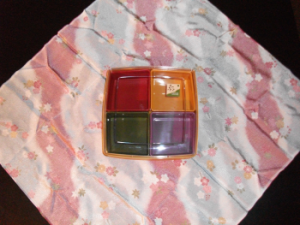
- Fold the top corner of the fabric down over the box as far as it will go without shifting the box from its place.
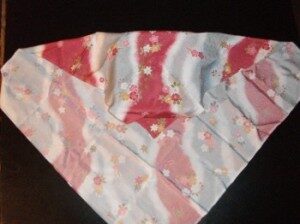
- Fold the bottom corner of the fabric over the last fold and the box as far as it will go. Don’t pull too hard. Let the bottom corner flop over the box without tucking it in.
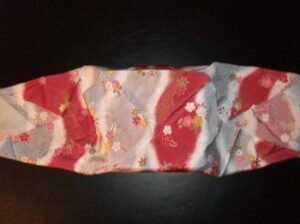
- Fold the left and then the right corners of the fabric across the box.
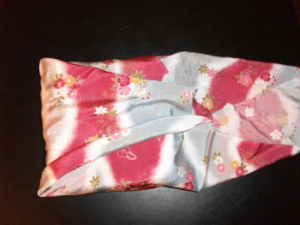
- Tie the left and right corners fairly tightly, but leave just a small amount of leeway in the fabric. (This will be the handle.)
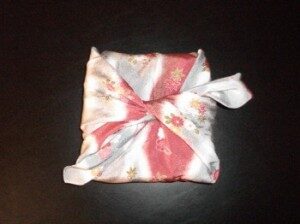
- Knot the two corners together. Make the knot tight enough so it won’t fall apart on its own, but loose enough that you won’t have difficulty getting the knot undone when you’re hungry!
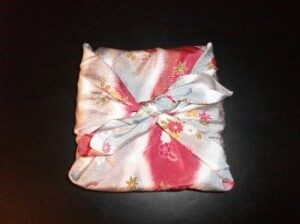
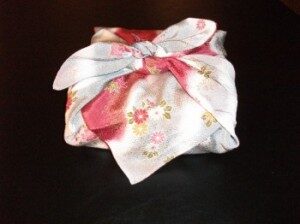
- Carry the box by the knot.
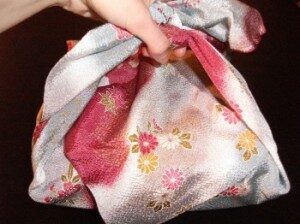
Hon-tsutsumi (“book wrap”):
Sometimes translated as “the briefcase” because it acts in a similar fashion, the hon-tsutsumi allows you to carry rectangular documents as well as books. You’ll need at least two piles of documents or two books of roughly the same height and width to make this wrap work.
- Place the furoshiki, non-decorated side (if applicable) face up, on a hard surface. The fabric should be in a normal square shape with the corners of the fabric at the left and right of the top and bottom. Place the books (or piles of documents) diagonally across the fabric toward the center. Leave a small amount of space between the books.
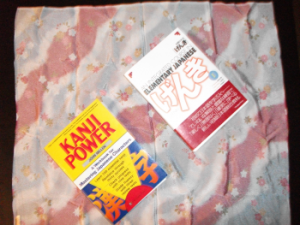
- Fold the bottom left and the top right corners of the fabric over the book that they are nearest. Tuck the corners under the book. Pull tightly, but make sure you don’t shift the books. There should still be a bit of space between the books.

- Pull the top left and the bottom right corners of the fabric across the books to the opposite side. The corners should stick out a bit beyond the books.
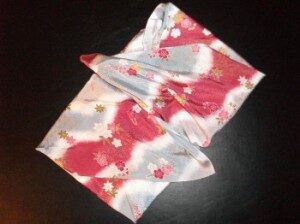
- Carefully flip one book over and stack it atop the other book. Make sure the corners of fabric that were sticking out before are still visible.
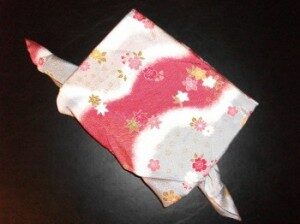
- Pull the two corners of fabric out and up and over the books (in the direction of the place where the book you just folded over originally was). Tie the two corners together somewhat tightly, but leave a little leeway. (This is the handle.) Knot the corners together as tightly as possible (but make sure you can easily undo the knot when necessary).
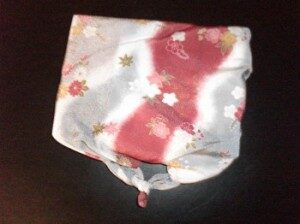
- Carry the books (or documents) by the knotted handle.
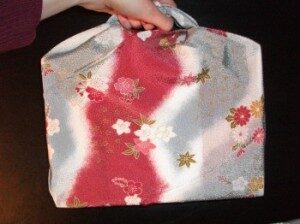
Bin-tsutsumi (“bottle wrap”):
Another popular use of the furoshiki is the bin-tsutsumi, which is used to wrap a single bottle either recently purchased or to be given as a gift. (There’s actually another method for wrapping two bottles at once.) Bottles intended for this wrap are traditionally tall and slender, such as wine and sake bottles.
- Place the furoshiki, non-decorated side (if applicable) face up, on a hard surface. The fabric should be rotated 90 degrees, with the corners of the fabric pointing up, down, left and right. Place the bottle standing up in the middle of the fabric.
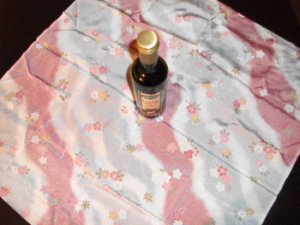
- Pull the left and right corners of the fabric up over the top of the bottle. Tie them together fairly tightly, but leave some leeway. (This will be the handle.) Knot the fabric together tightly, but make sure you’ll be able to undo the knot when needed.
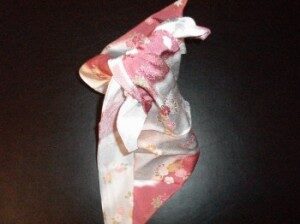
- Wrap the top corner of the fabric around the front (not the top) of the bottle as far as it will go. Wrap the bottom corner of the fabric across the last fold in the opposite direction.
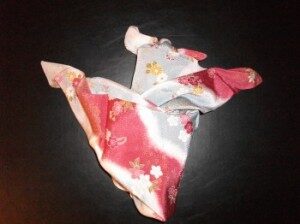
- Flip the bottle around. Grab both corners of the fabric that are sticking out and pull them as tight as they will go. Tie and knot the two corners together as tightly as possible without making the knot too hard to undo. (You will not be using this knot as a handle, so you won’t need any leeway. You want to make sure the knot is tight enough to keep the bottle in place.)
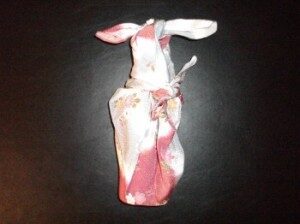
- Carry the bottle by the top knot of the fabric.
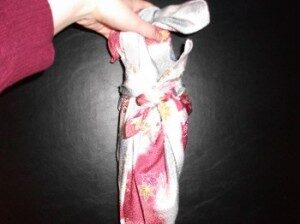
This post is an entry for Japan Blog Matsuri. Read about more Japanese how-tos at the Nihon Group website!
No related posts.
Tags: Food, furoshiki, japan, japanese culture, lunches


